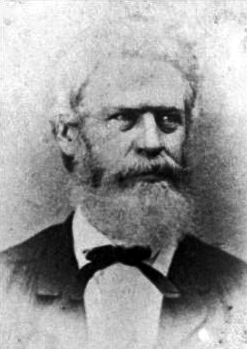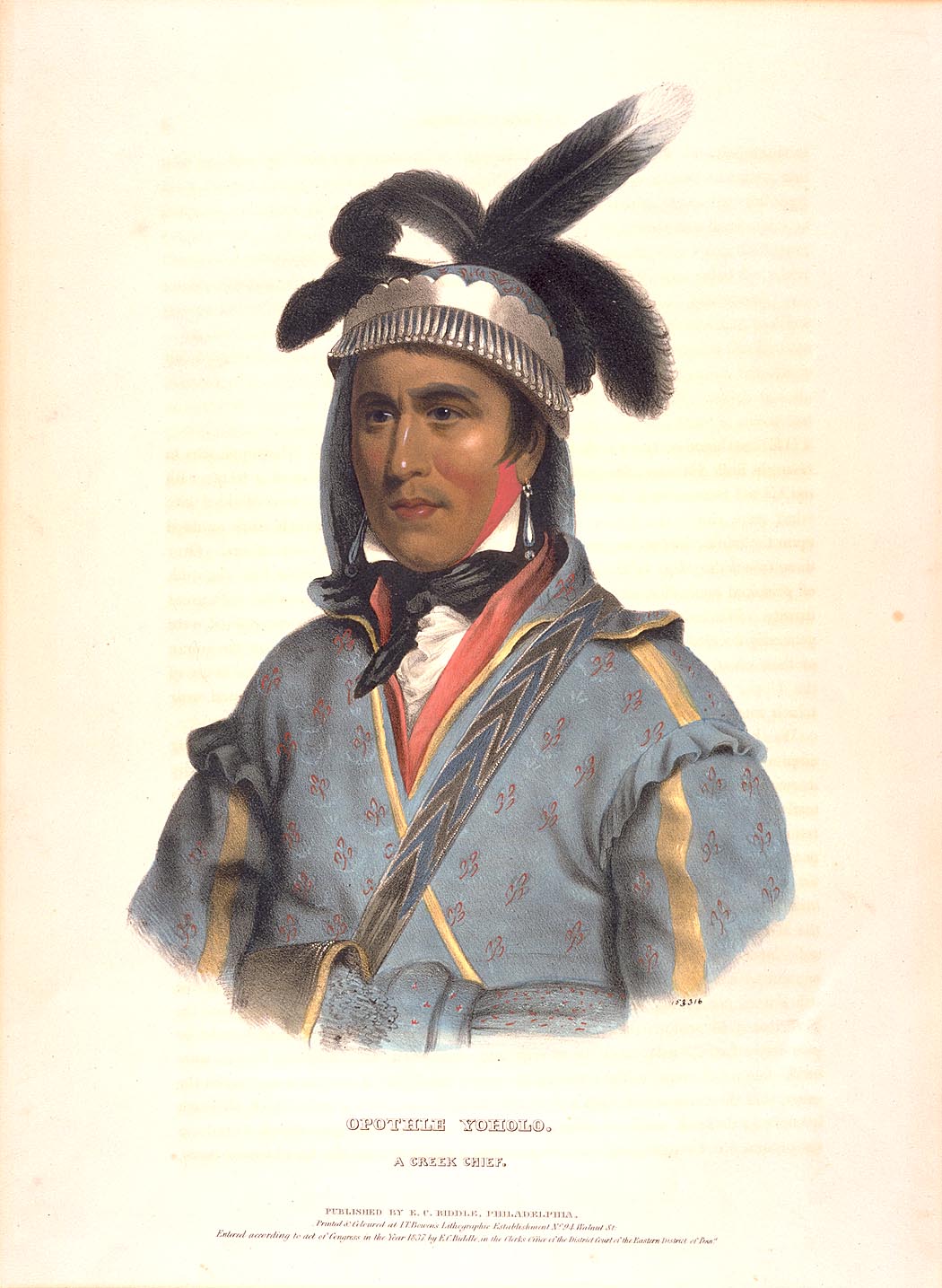|
D. N. McIntosh
Daniel Newnan McIntosh (1822–1896), often identified as D. N. McIntosh, was a Creek rancher, soldier and politician, the youngest son of Creek Chief William McIntosh (1790–1825). He was a member of one of the most influential Lower Creek families of the 19th century; after they migrated west in 1828, they continued as leaders of what was then called the Western Creek Nation. During the American Civil War, D. N. McIntosh organized a regiment and joined the Confederate States Army as a colonel. He was notable for recruiting and organizing the 1st Creek Mounted Volunteers and for leading them in several battles in Indian Territory. After the war, he continued as a farmer and rancher. Early years According to one source, Daniel Newnan McIntosh, known as "D.N.", was born near Newnan, Georgia. [...More Info...] [...Related Items...] OR: [Wikipedia] [Google] [Baidu] |
William McIntosh
William McIntosh (1775 – April 30, 1825),Hoxie, Frederick (1996)pp. 367-369/ref> was also commonly known as ''Tustunnuggee Hutke'' (White Warrior), was one of the most prominent chiefs of the Creek Nation between the turn of the nineteenth century and his execution in 1825. He was a chief of Coweta town and commander of a mounted police force. He became a large-scale planter, built and managed a successful inn, and operated a commercial ferry business. Early American historians attributed McIntosh's achievements and influence to his mixed race Scots/European ancestry. Since the late 20th century, historians have argued much of McIntosh's political influence stemmed more from his Creek upbringing and cultural standing, particularly his mother's prominent Wind Clan in the Creek matrilineal system, and to other aspects of Creek culture. Because McIntosh led a group that negotiated and signed the Treaty of Indian Springs in February 1825, which ceded much of remaining Creek lands t ... [...More Info...] [...Related Items...] OR: [Wikipedia] [Google] [Baidu] |
Battle Of Chusto-Talasah
The Battle of Chusto-Talasah, also known as Bird Creek, Caving Banks, and High Shoal, was fought December 9, 1861, in what is now Tulsa County, Oklahoma (then Indian Territory) during the American Civil War. It was the second of three battles in the Trail of Blood on Ice campaign for the control of Indian Territory during the American Civil War. A series of battles were fought in December in bad weather between the Confederate Cherokee and Choctaw Indians and the Union Creek and Seminole Indians (led by the Muscogee Creek chief Opothleyahola) who supported the Federal government. Following Opothleyahola and his Union force’s defeat at Round Mountain, he retreated northeastward in search of safety. On December 9, 1861, the force was at ''Chusto-Talasah'' (Caving Banks) on the Horseshoe Bend of Bird Creek when Col. Douglas H. Cooper’s 1,300 Confederates attacked about 2:00 p.m. Chief Opothleyahola knew Cooper was coming and had placed his troops in a strong positio ... [...More Info...] [...Related Items...] OR: [Wikipedia] [Google] [Baidu] |
People Of Indian Territory
A person ( : people) is a being that has certain capacities or attributes such as reason, morality, consciousness or self-consciousness, and being a part of a culturally established form of social relations such as kinship, ownership of property, or legal responsibility. The defining features of personhood and, consequently, what makes a person count as a person, differ widely among cultures and contexts. In addition to the question of personhood, of what makes a being count as a person to begin with, there are further questions about personal identity and self: both about what makes any particular person that particular person instead of another, and about what makes a person at one time the same person as they were or will be at another time despite any intervening changes. The plural form "people" is often used to refer to an entire nation or ethnic group (as in "a people"), and this was the original meaning of the word; it subsequently acquired its use as a plural form of per ... [...More Info...] [...Related Items...] OR: [Wikipedia] [Google] [Baidu] |
1896 Deaths
Events January–March * January 2 – The Jameson Raid comes to an end, as Jameson surrenders to the Boers. * January 4 – Utah is admitted as the 45th U.S. state. * January 5 – An Austrian newspaper reports that Wilhelm Röntgen has discovered a type of radiation (later known as X-rays). * January 6 – Cecil Rhodes is forced to resign as Prime Minister of the Cape of Good Hope, for his involvement in the Jameson Raid. * January 7 – American culinary expert Fannie Farmer publishes her first cookbook. * January 12 – H. L. Smith takes the first X-ray photograph. * January 17 – Fourth Anglo-Ashanti War: British redcoats enter the Ashanti capital, Kumasi, and Asantehene Agyeman Prempeh I is deposed. * January 18 – The X-ray machine is exhibited for the first time. * January 28 – Walter Arnold, of East Peckham, Kent, England, is fined 1 shilling for speeding at (exceeding the contemporary speed limit of , the first sp ... [...More Info...] [...Related Items...] OR: [Wikipedia] [Google] [Baidu] |
1822 Births
Eighteen or 18 may refer to: * 18 (number), the natural number following 17 and preceding 19 * one of the years 18 BC, AD 18, 1918, 2018 Film, television and entertainment * ''18'' (film), a 1993 Taiwanese experimental film based on the short story ''God's Dice'' * ''Eighteen'' (film), a 2005 Canadian dramatic feature film * 18 (British Board of Film Classification), a film rating in the United Kingdom, also used in Ireland by the Irish Film Classification Office * 18 (''Dragon Ball''), a character in the ''Dragon Ball'' franchise * "Eighteen", a 2006 episode of the animated television series ''12 oz. Mouse'' Music Albums * ''18'' (Moby album), 2002 * ''18'' (Nana Kitade album), 2005 * '' 18...'', 2009 debut album by G.E.M. Songs * "18" (5 Seconds of Summer song), from their 2014 eponymous debut album * "18" (One Direction song), from their 2014 studio album ''Four'' * "18", by Anarbor from their 2013 studio album '' Burnout'' * "I'm Eighteen", by Alice Cooper common ... [...More Info...] [...Related Items...] OR: [Wikipedia] [Google] [Baidu] |
First Battle Of Cabin Creek
The First Battle of Cabin Creek took place on July 1 through July 2, 1863, in Mayes County, Oklahoma during the American Civil War. The Confederate forces under Colonel Stand Watie attempted to ambush a Union supply convoy led by Colonel James Monroe Williams. Williams was alerted to the attack and, despite the waters of the creek being swelled by rain, made a successful attack upon the entrenched Confederate position and forced them to flee. The raid by a Confederate Army detachment on a Union Army supply train bound for Fort Gibson in July 1863 failed to stop the Union detachment, which enabled the Union to succeed in winning the Battle of Honey Springs later that month. The battle was the first in which African American troops fought side-by-side with their white comrades. Two Civil War military engagements were fought at the Cabin Creek battlefield in the Cherokee Nation within Indian Territory. The location was where the Texas Road crossed Cabin Creek, near the present- ... [...More Info...] [...Related Items...] OR: [Wikipedia] [Google] [Baidu] |
Battle Of Honey Springs
The Battle of Honey Springs, also known as the Affair at Elk Creek, on July 17, 1863, was an American Civil War engagement and an important victory for Union forces in their efforts to gain control of the Indian Territory. It was the largest confrontation between Union and Confederate forces in the area that would eventually become Oklahoma. The engagement was also unique in the fact that white soldiers were the minority in both fighting forces. Native Americans made up a significant portion of each of the opposing armies and the Union force contained African-American units. The battleground is about northeast of what is now Checotah, Oklahoma and south of Muskogee.Freeman, Charles R "The Battle of Honey Springs." In: ''Chronicles of Oklahoma''. Volume 13, Number 2. June, 1935. Retrieved January 31, 2014. It was also about southwest of Fort Gibson. [...More Info...] [...Related Items...] OR: [Wikipedia] [Google] [Baidu] |
Battle Of Old Fort Wayne
The Battle of Old Fort Wayne, also known as Maysville, Beattie's Prairie, or Beaty's Prairie, was an American Civil War battle on October 22, 1862, in Delaware County in what is now eastern Oklahoma. Confederate Major General Thomas C. Hindman, commander of the Trans-Mississippi Department, had ordered his troops to put down bushwhackers in southwest Missouri and northwest Arkansas. At the time, Colonel Douglas H. Cooper and his Indian Brigade were stationed near Newtonia, Missouri, preparing to move to Springfield, Missouri. Hindman ordered Cooper to hold Newtonia until he could move other troops to surround Springfield. There were several skirmishes between Confederate and Union forces from September 30 and October 3. On October 4, Blunt's troops surrounded Newtonia on three sides. Cooper and his Indian forces beat a hasty retreat back to Indian Territory. [...More Info...] [...Related Items...] OR: [Wikipedia] [Google] [Baidu] |
Battle Of Pea Ridge
The Battle of Pea Ridge (March 7–8, 1862), also known as the Battle of Elkhorn Tavern, took place in the American Civil War near Leetown, northeast of Fayetteville, Arkansas. Federal forces, led by Brig. Gen. Samuel R. Curtis, moved south from central Missouri, driving Confederate forces into northwestern Arkansas. Maj. Gen. Earl Van Dorn had launched a Confederate counteroffensive, hoping to recapture northern Arkansas and Missouri. Curtis held off the Confederate attack on the first day and drove Van Dorn's force off the battlefield on the second. The battle was one of the few in which a Confederate army outnumbered its opponent. By defeating the Confederates, the Union forces established Federal control of most of Missouri and northern Arkansas. Background Union forces in Missouri during the latter part of 1861 and early 1862 had pushed the Confederate Missouri State Guard under Maj.-Gen. Sterling Price out of the state. By spring 1862, Federal Brig. Gen. Samuel R. C ... [...More Info...] [...Related Items...] OR: [Wikipedia] [Google] [Baidu] |
Battle Of Chustenahlah
The Battle of Chustenahlah was fought in Osage County, Oklahoma, (then Indian Territory) on December 26, 1861, during the American Civil War. A band of 9,000 pro-Union Native Americans was forced to flee to Kansas in bitter cold and snow in what became known as the Trail of Blood on Ice. Background Confederate troops undertook a campaign to subdue the Native American Union sympathizers in Indian Territory and consolidate control. They attacked Chief Opothleyahola's band of Creek and Seminole (led by Chief Halek Tustenuggee) at Round Mountain and Chusto-Talasah. The Confederates wanted to finish off the Indians by attacking them in their camp at ''Chustenahlah'' (corruption of the Cherokee word ''"U-s-ta-la-na",'' meaning a shoal or sandbar in a stream or creek) in a well-protected cove on Bird Creek. Colonel James M. McIntosh and Col. Douglas H. Cooper, commanding the Indian Department, planned a combined attack with each of their columns moving on the camp from different ... [...More Info...] [...Related Items...] OR: [Wikipedia] [Google] [Baidu] |
Battle Of Round Mountain
The Battle of Round Mountain was the first battle in the Trail of Blood on Ice campaign for the control of Indian Territory during the American Civil War that occurred on November 19, 1861. Its main purpose was to prevent Union supporters of the Creek Nation, led by Opothleyahola from fleeing Indian Territory to the protection of Union forces in Kansas. The physical location of the battle is in dispute. Some historians believe it to be near Keystone while others contend that it is near Yale, Oklahoma. The event is sometimes referred to as the Battle of Red Fork.Debo, Angie. "The Site of the Battle of Round Mountain, 1861". ''Chronicles of Oklahoma''. Vol. XXVII, No. 2 (Summer, 1949) pp. 187-206. Acces ... [...More Info...] [...Related Items...] OR: [Wikipedia] [Google] [Baidu] |


_1938.jpg)
.jpg)




